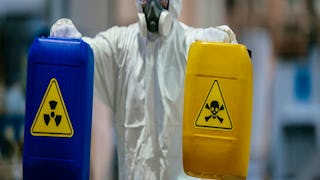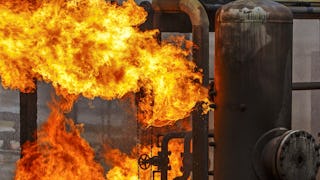Discover the core principles of process safety and risk analysis in chemical engineering through our dynamic course. Gain expertise in modeling liquid and gas leaks, accurately assessing potential material releases, and calculating downwind exposures to toxic chemicals using state-of-the-art dispersion models. This course equips chemical engineers with essential skills to evaluate and mitigate hazardous concentrations effectively, ensuring industrial process safety. From theoretical foundations to practical applications, participants will learn to propose prevention measures and advance their careers in chemical engineering. Join us to elevate your proficiency in process safety and make a meaningful impact in the field.


Predictive Models for Toxic Chemical Releases
本课程是 Chemical Hazards and Process Safety 专项课程 的一部分

位教师:Jason White
2,388 人已注册
包含在 中
您将获得的技能
要了解的详细信息

添加到您的领英档案
4 项作业
了解顶级公司的员工如何掌握热门技能

积累特定领域的专业知识
- 向行业专家学习新概念
- 获得对主题或工具的基础理解
- 通过实践项目培养工作相关技能
- 获得可共享的职业证书

该课程共有4个模块
After this module, you will be able to describe the terms that make up the mechanical energy balance. You will be able to apply the mechanical energy balance to derive a simple source model for a liquid leak through a hole and be able to extend the simple source model for liquid leak through a hold to account for a situation where the change in liquid level is significant. You will also be able to incorporate frictional losses in piping systems into liquid source model derivation.
涵盖的内容
9个视频4篇阅读材料1个作业1个讨论话题
After this module, you will be able to apply the mechanical energy balance to derive a simple source model for a gas leak through a hole. You will also be able to use models of adiabatic and isothermal gas or vapor flows through pipes and understand challenges with deriving models for such flows. You will be able to estimate volatile vapor component concentrations in enclosed spaces and assess the potential for hazardous concentrations and be able to describe source model selection for scenarios involving flashing liquids.
涵盖的内容
8个视频4篇阅读材料1个作业1个讨论话题
After this module, you will be able to describe air dispersion and the parameters required to describe it. You will be able to formulate neutrally buoyant plume dispersion models. You'll also be able to perform calculations using plume models and use results to identify potential hazardous situations and propose prevention/mitigation measures if necessary.
涵盖的内容
6个视频2篇阅读材料1个作业
After this module, you will be able to formulate neutrally buoyant puff models and be able to describe isopleths and how they are used in evaluating puff models. You will be able to perform calculations using puff models and use results to identify potential hazardous situations and propose prevention/mitigation measures if necessary.
涵盖的内容
7个视频4篇阅读材料1个作业1个讨论话题
获得职业证书
将此证书添加到您的 LinkedIn 个人资料、简历或履历中。在社交媒体和绩效考核中分享。
位教师

从 Chemistry 浏览更多内容
 状态:免费试用
状态:免费试用University of California, Davis
 状态:免费试用
状态:免费试用University of California, Davis
 状态:免费试用
状态:免费试用University of California, Davis
 状态:免费试用
状态:免费试用University of California, Davis
人们为什么选择 Coursera 来帮助自己实现职业发展




学生评论
52 条评论
- 5 stars
62.96%
- 4 stars
31.48%
- 3 stars
5.55%
- 2 stars
0%
- 1 star
0%
显示 3/52 个
已于 Jan 20, 2025审阅
Very interesting, found the math quite hard but the theory made sense and was very worthwhile.
已于 Oct 4, 2024审阅
The course is useful in day-to-day activities and process safety concern.
常见问题
To access the course materials, assignments and to earn a Certificate, you will need to purchase the Certificate experience when you enroll in a course. You can try a Free Trial instead, or apply for Financial Aid. The course may offer 'Full Course, No Certificate' instead. This option lets you see all course materials, submit required assessments, and get a final grade. This also means that you will not be able to purchase a Certificate experience.
When you enroll in the course, you get access to all of the courses in the Specialization, and you earn a certificate when you complete the work. Your electronic Certificate will be added to your Accomplishments page - from there, you can print your Certificate or add it to your LinkedIn profile.
Yes. In select learning programs, you can apply for financial aid or a scholarship if you can’t afford the enrollment fee. If fin aid or scholarship is available for your learning program selection, you’ll find a link to apply on the description page.
更多问题
提供助学金,



